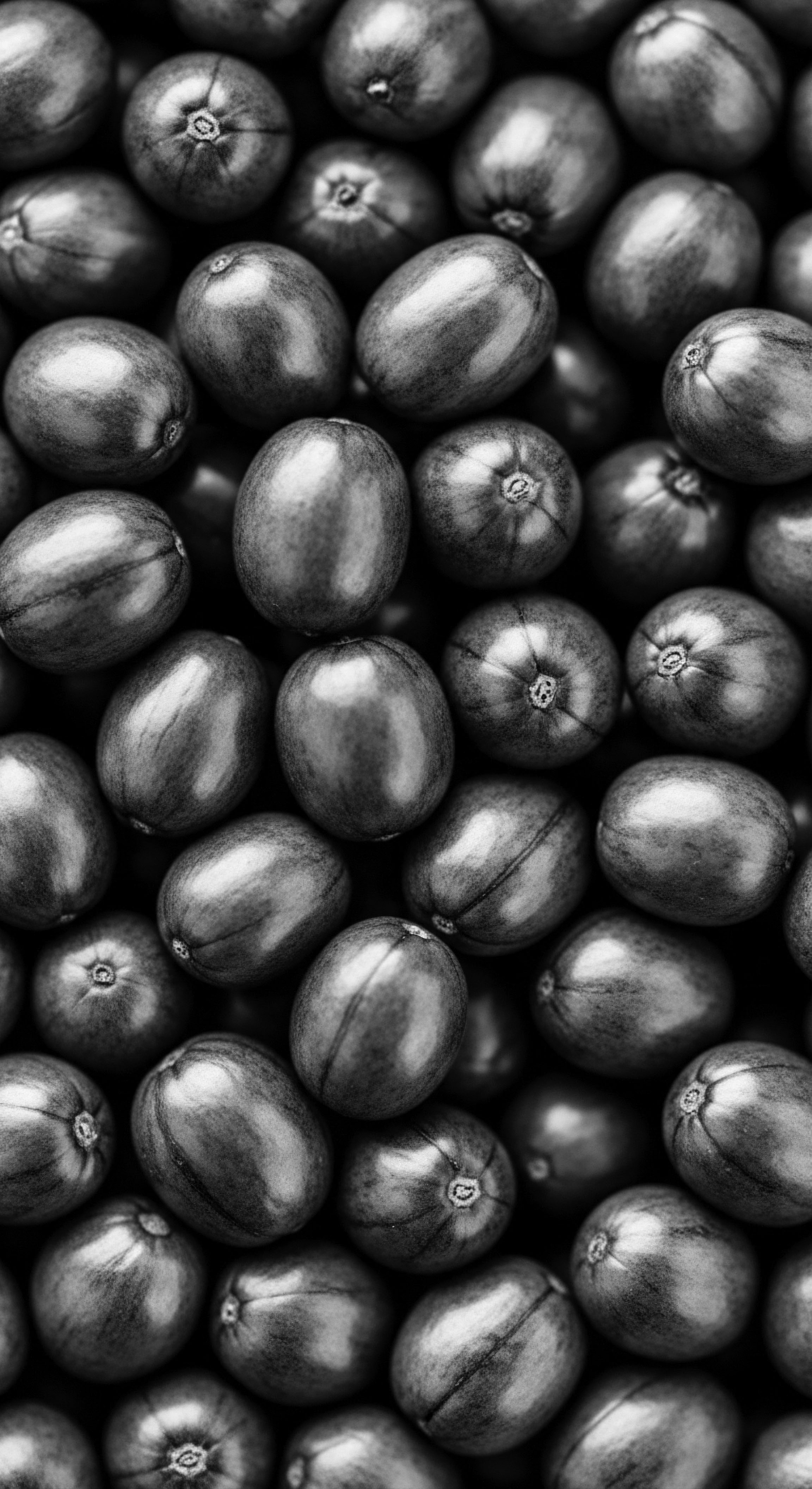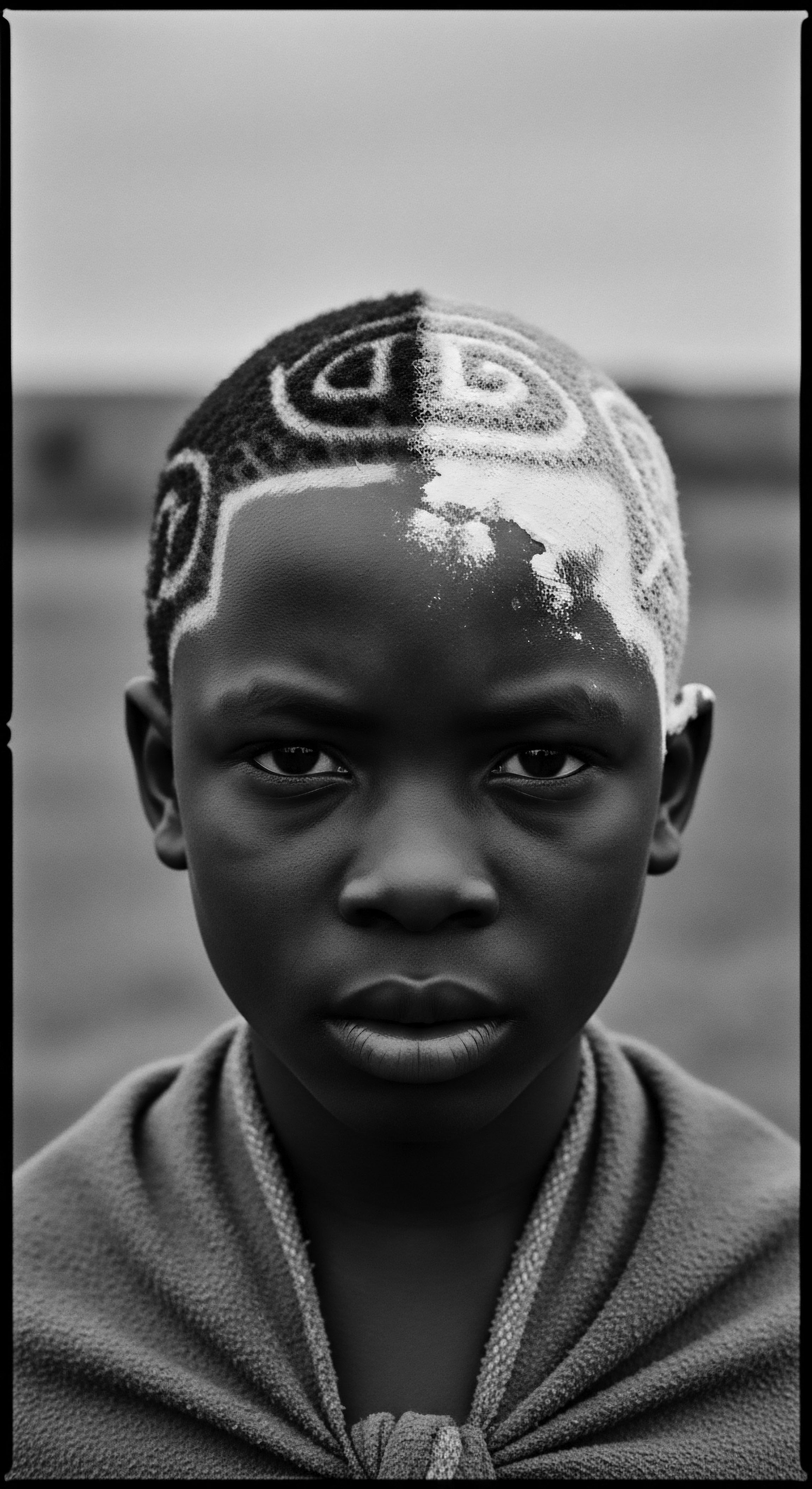
Fundamentals
The history of indigo dye whispers across millennia, a vibrant blue telling a story of human ingenuity, cultural exchange, and deep connection to the Earth’s generous offerings. At its most straightforward, indigo dye is a natural pigment, a remarkable blue hue derived from the leaves of certain plants, primarily those within the Indigofera genus. This botanical marvel, most famously the Indigofera Tinctoria species, has given its profound color to textiles, art, and even human adornment for thousands of years.
From its earliest recognition, the plant held a special place. Its leaves, seemingly unassuming, held a secret chemical potential, waiting for human hands to unlock its vivid blue. The transformation from green foliage to resplendent blue was, in ancient times, nothing short of alchemical, a testament to ancestral understanding of the natural world. This understanding extended far beyond mere coloring for fabric; it touched upon aspects of personal care and spiritual practices.
Indigo dye, at its core, is a natural blue pigment sourced from specific plants, cherished for its ancient application in coloring and personal adornment.
Across various civilizations, the significance of indigo grew. In some regions, its use was purely utilitarian for textiles, but in others, its rich blue took on deeper layers of communal value and individual expression. It became a medium for storytelling, a visual language woven into the fabric of daily existence and special ceremonies. The journey of indigo from a humble plant to a revered pigment is a testament to humanity’s ancient and abiding relationship with botanical wisdom.

The Plant Source and Early Uses
The primary source of this esteemed blue is the Indigofera tinctoria plant, a small shrub whose native range spans parts of Western tropical Africa, Tanzania, South Africa, and the Indian Subcontinent into Indo China. This plant is not alone, however; other species within the Indigofera family and even different plants like Lonchocarpus cyanescens in West Africa also yield indigo pigment. The process of extracting the dye involves a fascinating biological conversion.
The leaves contain a colorless compound called indican, which, through careful fermentation and subsequent exposure to oxygen, transforms into the insoluble blue pigment known as indigotin. This intricate process, discovered and perfected by ancient peoples, marked a significant advancement in the human capacity to harness nature’s palette.
Beyond its renowned role in dyeing textiles, indigo’s application extended to personal cosmetics and even medicinal uses in various cultures. In Europe, it served as a hair dye and eye cosmetic. West African women, in their ancestral practices, used indigo not only for cloth but also rubbed it into their hair and skin, painted their bodies, and employed it for tattooing. Such widespread application underscores the plant’s versatility and its deep integration into the daily lives and cultural practices of communities across continents.

Intermediate
Stepping beyond the elemental description, the history of indigo dye unfolds as a profound narrative, particularly when viewed through the lens of textured hair heritage. This natural pigment’s journey from cultivation to application reveals layers of ancestral knowledge, community rituals, and embodied cultural significance. The very process of coaxing blue from green leaves, a testament to ancient science, speaks to a holistic understanding of nature’s offerings, an understanding that often intertwined with personal care.

Unveiling the Blue ❉ The Extraction Process
The deep blue of indigo, so cherished throughout history, does not simply present itself upon harvesting the plant. Its manifestation requires a deliberate, alchemical journey. The leaves of the indigo plant contain a compound called Indican, which itself is not blue. The crucial step involves fermentation, where the indican is released from the leaves.
Subsequently, when this fermented liquid is exposed to air, the indican oxidizes, chemically transforming into Indigotin, the vibrant, insoluble blue pigment that gives indigo its renown. This transformation, a sight of wonder for ancient practitioners, involved a meticulous series of steps:
- Harvesting and Soaking ❉ Fresh indigo leaves were gathered and submerged in water, often in large vats or pits. This initiated the fermentation process.
- Fermentation and Agitation ❉ Over several days, the mixture would ferment, often accompanied by a distinct odor and foaming surface, indicating the release of the indican compound. The liquid might be agitated to introduce oxygen.
- Oxidation and Precipitation ❉ As air was introduced, the liquid would visibly change from greenish to blue, and the indigotin would separate as blue flakes or sediment.
- Drying and Processing ❉ The blue sediment was then collected, pressed, and dried, often into cakes or balls, ready for storage and trade.
This process, honed over centuries, varied subtly across regions, yet the fundamental scientific principle remained constant. It speaks to a deep, experiential scientific understanding held by our ancestors, a knowledge passed down through generations.
The captivating blue of indigo emerges through a precise biochemical transformation, involving fermentation and oxidation, a testament to ancient botanical knowledge.

Cultural Threads ❉ Indigo Beyond the Loom
While indigo’s fame largely stems from its role in textiles—adorning everything from ceremonial robes in West Africa to kimonos in Japan—its significance extends into various cultural traditions, rituals, and artistic expressions. It was a pigment of spiritual connotation, often symbolizing purity or protection. In many African contexts, indigo-dyed cloth was not merely decorative; it was a medium for storytelling and ceremonial dress, embodying social status and prosperity.
For communities across West Africa, the connection to indigo was particularly profound. From the Yoruba of Nigeria to the Manding of Mali, and the Hausa of Kano, artisans, often women, were renowned for their expertise in processing and dyeing with indigo. These traditions were not simply technical skills; they were often interwoven with spiritual guidance and ritual practices to ensure the dye’s success.
The application of indigo also extended directly to the body and hair. West African women applied indigo paste to their skin and hair, utilizing its properties for various purposes. This practice was not merely cosmetic; it frequently carried symbolic weight, indicating status, beauty, or even spiritual connection. The color blue itself, derived from this cherished plant, became a visual marker within communities, communicating messages about identity and belonging.

Indigo in Ancestral Hair Care
The application of indigo to textured hair is a testament to ancient populations’ resourcefulness and deep botanical wisdom. Before the advent of synthetic dyes, plant-based remedies were the standard for hair care, offering both coloring and conditioning properties. Indigo powder, when mixed with water to create a paste, offers a natural alternative for darkening hair, providing shades from deep brown to jet black, especially when combined with henna. This practice was not merely about aesthetic alteration; it also served to nourish and condition hair, promoting shine and reducing dryness, speaking to a holistic approach to wellbeing.
This historical use of indigo for hair exemplifies a principle found in many ancestral hair traditions ❉ that beauty and health are interconnected. The botanical compounds within indigo plants were understood, through generations of empirical observation, to possess properties that transcended simple color. For those with textured hair, which often requires specific moisture and conditioning, indigo’s conditioning attributes would have been particularly valuable, offering a gentle yet effective way to adorn and care for the hair.

Academic
The history of indigo dye, when subjected to scholarly examination, expands into a complex, multi-layered definition, encompassing not only its botanical origins and chemical properties but also its profound socio-economic and cultural significance, particularly for textured hair heritage. This deep exploration reveals indigo as a potent symbol and a tangible link to ancestral practices, resilience, and identity within Black and mixed-race communities across the globe.
A comprehensive definition of Indigo Dye History positions it as the scholarly investigation into the transcultural evolution of indigotin -yielding plant species, their cultivation, processing, and application, with a particular focus on the enduring cultural connotations and material practices associated with its distinctive blue pigment within global heritage economies and ancestral cosmetic traditions, especially those pertaining to Black and mixed-race hair experiences. This interpretation moves beyond a simple chronological account to analyze its deep, often contested, relationships with human societies, labor systems, and the preservation of indigenous knowledge systems, notably in hair care.

The Biophysical and Historical Genesis of Blue
The botanical foundation of indigo lies predominantly in the Indigofera tinctoria species, a leguminous plant whose leaves contain a glucoside precursor, indican. The technical process for dye extraction, honed over millennia, is an exercise in controlled biochemical transformation. Upon maceration and fermentation in alkaline solutions, enzymes hydrolyze indican into indoxyl, which then oxidizes upon exposure to atmospheric oxygen, forming the characteristic blue pigment, indigotin.
This enzymatic and oxidative conversion was a closely guarded secret, a testament to empirical scientific discovery preceding formal chemical nomenclature. Other species, including Lonchocarpus cyanescens in West Africa, also served as vital sources, demonstrating a regional diversity in the plant’s sourcing.
The historical trajectory of indigo is expansive, dating back at least 6,000 years, with evidence of its use on a Peruvian textile from that period. India stood as the initial global epicenter of indigo cultivation and trade, its “nila” a prized commodity in ancient networks, influencing civilizations from Egypt to East Asia. Archaeological discoveries from the Indus Valley Civilization (circa 2000 BCE) corroborate early examples of indigo-dyed textiles, solidifying India’s ancient mastery.

The Unseen Labor ❉ Indigo’s Connection to Enslavement and Knowledge Transfer
The academic understanding of indigo dye history is incomplete without acknowledging its profound and often brutal entanglement with the transatlantic slave trade and colonial economies. Indigo became a cornerstone commodity, a “blue gold,” fueling colonial empires alongside cotton and sugar. The cultivation and processing of indigo were labor-intensive endeavors. Crucially, enslaved Africans possessed a deep, inherited knowledge of indigo cultivation, harvesting, and processing techniques, skills honed over centuries in West Africa, where indigo dyeing traditions were centuries old.
This specialized knowledge was not merely a convenient labor source for colonizers; it represented a direct transfer of sophisticated agricultural and chemical expertise from Africa to the Americas. Eliza Lucas Pinckney, often credited with introducing indigo to the American colonies in the mid-1700s, relied heavily on the forced expertise of enslaved Africans, whose ancestral methods were instrumental in establishing indigo as a major cash crop in the American South, particularly South Carolina. This period marks a harrowing example of how indigenous knowledge, inextricably linked to the heritage of enslaved peoples, was exploited for colonial wealth, yet simultaneously, this knowledge persisted within the diasporic experience.
The historical production of indigo in colonial contexts frequently relied on the exploited ancestral knowledge of enslaved Africans, whose expertise in cultivating and processing the dye represented a profound, often unacknowledged, transfer of agricultural and chemical science.
The continuity of this inherited botanical and dyeing wisdom, despite oppressive conditions, manifests in myriad ways, including the very practices of self-care and adornment among enslaved and later diasporic Black communities. The knowledge of natural ingredients, like indigo, for hair and skin applications, continued as a form of cultural retention and resistance.

Indigo as a Repository of Black Hair Heritage and Identity
Beyond its economic utility, indigo holds a significant place in the narrative of Black and mixed-race hair heritage, serving as more than a simple colorant. Its application to hair and skin in West African cultures, long before colonial encounters, was deeply embedded in social status, spirituality, and identity. For instance, Catherine E.
McKinley, in her scholarship, notes that in photographs and postcards from the late 1800s and early 1900s, there is evidence of West African women of prestige wearing indigo-dyed cloth, sometimes with Indigo Paste Covering Their Hair beneath Their Head Wraps, a clear indication of power and nobility. This particular example powerfully illuminates how indigo’s direct connection to hair was not merely cosmetic but a profound statement of self and societal standing.
This ritualistic application of indigo to hair signifies an ancestral practice where hair was a conduit for meaning, a site of spiritual expression, and a marker of identity. The deep blue hue, associated with the mystical and the powerful, would have physically and symbolically wrapped the wearer in layers of heritage. This understanding aligns with ethnographic research exploring hair’s communicative role in Black diasporic communities.
As Océane Nyela (2021) suggests, African hair and hair practices are integral to diasporic transindividuation, serving as a site of identity formation and cultural memory. The use of indigo, then, contributes to this larger “grammar of hair,” demonstrating continuity of traditional practices even as contexts shifted.
This deep-seated connection allowed indigo to persist within Black communities, not just as a dye for fabric, but also for hair, even in the face of pressures to conform to Eurocentric beauty standards. The endurance of such practices speaks to the resilience of cultural memory, a quiet defiance against erasure. The preparation and application of indigo for hair, perhaps mixed with other traditional ingredients like henna, became a ritual of self-affirmation, a way to maintain connections to ancestral lands and wisdom.

Modern Echoes ❉ Ancestral Wisdom in Contemporary Care
The contemporary resurgence of natural hair movements and holistic wellness practices finds a clear lineage in the ancestral uses of indigo. Modern hair care enthusiasts, seeking alternatives to synthetic chemicals, are revisiting plant-based solutions, including indigo powder, for coloring and conditioning textured hair. This deliberate return to nature-derived ingredients is often a conscious act of reclaiming heritage, honoring the wisdom of those who came before. The understanding of indigo’s natural composition and its benefits for hair health—such as conditioning and providing a chemical-free darkening agent—validates ancient empirical knowledge through modern scientific inquiry.
The history of indigo dye, therefore, is not a static chronicle but a living narrative. It informs our perception of hair as a profound element of identity, particularly for individuals of Black and mixed-race descent. Its story encapsulates centuries of innovation, trade, exploitation, resistance, and the enduring power of cultural inheritance expressed through something as intimate as hair care. It reveals that ancestral practices were often rooted in deep, practical knowledge, offering sustainable and holistic approaches to wellbeing that continue to guide us today.

Reflection on the Heritage of Indigo Dye History
The whispers of indigo’s history linger in the very strands of our textured hair, a gentle hum of ancestral wisdom connecting past to present. As a natural historian of hair traditions, I sense in this narrative more than just the journey of a pigment; I recognize the enduring spirit of resilience, the tender care passed down through generations, and the profound power of self-expression. The deep, resonant blues of indigo are, to me, not just a color, but a symbol of the depths of our heritage, the intricate beauty of Black and mixed-race hair experiences, and the persistent ancestral practices that continue to guide our understanding of beauty and well-being.
To hold indigo powder, whether in one’s palm or mind, is to hold a piece of living history. It is to acknowledge the skilled hands of those who first transformed green leaves into blue magic, to feel the echoes of women who adorned their hair with its rich paste as a sign of power, and to remember the tenacity of those who carried this knowledge across oceans, defying the brutal forces of erasure. This plant, so humble in its form, became a silent archive, holding within its very fibers the stories of communities, their rituals, and their unyielding connection to the Earth.
The enduring spirit of indigo in textured hair traditions is a powerful symbol of resilience, ancestral wisdom, and the beauty of self-expression.
The story of indigo is a testament to how our ancestors understood the world not just as a collection of resources but as a living, interconnected entity. They observed, experimented, and developed sophisticated methods, validating their intuition with tangible results that nourished both body and spirit. This wisdom reminds us that true hair care, particularly for textured hair, is often found in the gentle embrace of natural elements and time-honored practices, rather than fleeting trends. It invites us to pause, to listen to the silent lessons held within each curl and coil, recognizing that our hair itself is a living chronicle of our lineage.
As we continue to rediscover and integrate these ancestral practices into our contemporary lives, the meaning of indigo deepens. It becomes a metaphor for the continuous unfolding of our heritage, a vibrant thread stitching together the past, present, and future of textured hair. Its enduring blue reminds us that beauty rooted in tradition is timeless, profound, and always connected to the vibrant soul of a strand.

References
- McKinley, Catherine E. Indigo ❉ In Search of the Color that Seduced the World. Bloomsbury Publishing, 2011.
- Nyela, Océane. “Braided Archives ❉ Black hair as a site of diasporic transindividuation.” Thesis, York University, 2021.
- Splitstoser, Jeffrey C. et al. “Early evidence for textile dyeing from the Andes.” Science Advances, vol. 2, no. 9, 2016.
- Balfour-Paul, Jenny. Indigo ❉ Egyptian Mummies to Blue Jeans. British Museum Press, 2011.
- Pastoureau, Michel. Blue ❉ The History of a Color. Princeton University Press, 2001.
- Lee, T. W. The World of Natural Dyes. The Federation of Korean Textile Industries, 2010.
- Jisha, V. S. and S. Benjamin. “A review on the antimicrobial properties of medicinal plants.” Journal of Advanced Pharmaceutical Technology & Research, vol. 1, no. 2, 2010.
- Samanta, A. K. A. Basak, and S. Chattopadhyay. “Natural Dyes and Their Application to Textiles ❉ A Review.” Textile and Garment Industry, 2014.
- Sri Bhuvaneswar, T. K. et al. “Formulation and Evaluation of Herbal Hair Dye.” International Journal of Pharmaceutical Sciences Review and Research, vol. 68, no. 1, 2021.
- Warner-Lewis, Maureen. Guinea’s Other Suns ❉ The African Dynamic in Trinidad Culture. Majority Press, 1993.
